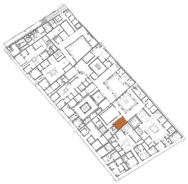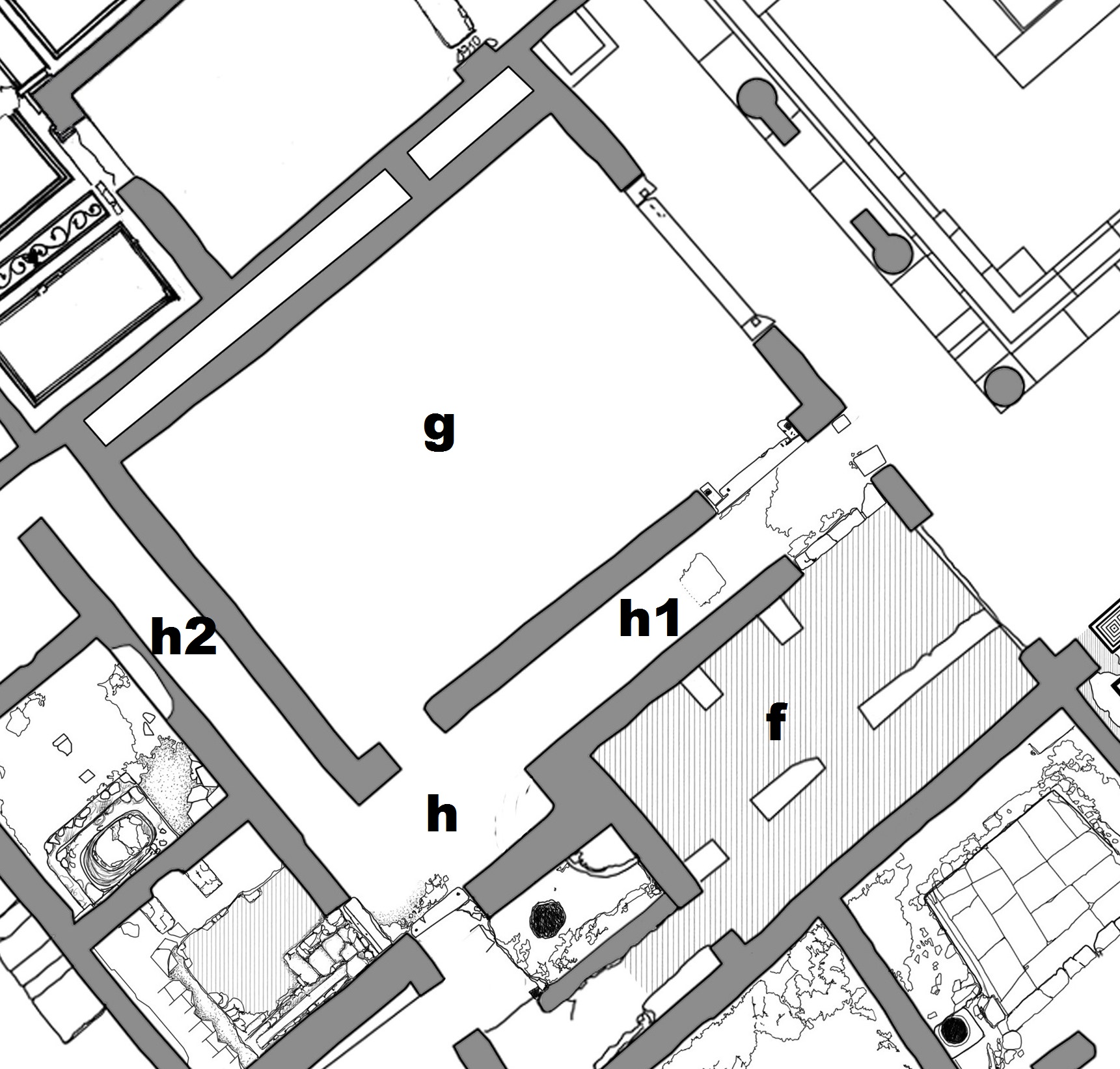Room f
Description
Thomas Staub
Room f, reminds with its dimensions (6.3 m x 3.7 m) of a traditional triclinium. Probably both this room and some later abolished rooms beneath the latest floor level of room g were constructed after that at least parts of the neighbouring house had been acquired (if it wasn't a joint ownership from the beginning) and the original boundary wall between V 1,7 and its western neighbour had been largely pulled down. A larger cellar, divided into a corridor and three small rooms was installed underneath this room, whose floor has collapsed either during the eruption or after the excavation (this room probably was excavated a first time already as part of the absolute first excavations in Pompeii in April 1748, cf. the plan by Fiorelli, Descrizione di Pompei). Only at the northern end of the west wall of the peristyle, do some remains of opus incertum of lava set into the reddish mortar remain from this original boundary. The lower parts under this wall, visible from the cellar underneath room f and consisting of slightly larger pieces of lava, are possibly parts of the original foundations of this wall.
Room f was probably under redecoration at the moment of the eruption, since both the south and the west wall show holes for the attaching of scaffoldings which were needed for the redecoration works at the upper zones of the wall (see comments). On the south wall, only the westernmost stripe, 1.3 m wide, is covered with plaster. On the north wall and on the southern part of the east wall, some remains of plaster are preserved, but without any traces of decorations. Where the underlying coarse plaster on the north wall is visible, clear trowel traces are discernible.
The walls of room f are built of a mixed incertum set into a light yellow mortar, except for the door frames towards the peristyle, which at the south side is made up of bricks and at the northern side is constructed of a mixture of Sarno stone, opus reticulatum and bricks. Of the floor only some pieces are preserved next to the door towards the peristyle. There it consists of a greyish lava-lime mortar with inlaid white (partly marble) and grey, both regularly and irregularly cut pieces of stone. Else the floor has collapsed into the cellar underneath. In the north wall, a second door was opened up, probably in a second stage in the history of that room, towards the corridor h1 at the northeastern corner, possibly, notwithstanding its relative width (1.9 m), functioning as a serving entrance.
The creation of triclinium f must belong to the rebuilding phase in late republican times, before the creation of the cenatiog. This is indicated by four observations. The first one is the later filled in niche for a cline in the outside of the north wall (i.e., the wall of the adjacent later abolished room g 1). Since no joints are visible in the north wall of room f, this wall must have been erected in its entire width at the same time as room g 1 with its niche. The second observation concerns the building material mainly of the frames of the door between room f and the peristyle. This material is either block of Sarno stone and opus reticulatum, or, in a probable later repair, tiles, but 'tuffeli' are not used here. All the other door frames in the western part of this house are constructed of these 'tuffeli2, including the west frame of the door between room f and corridor h1, which was opened up when the rooms g1 - g3 were torn down and corridor h1 was built. The third observation could be made with the aid of aerial photographs of this part of the insula (These photographs were taken by J.-P. Brun and his team. I would like to express my gratitude to them for these pictures and for the possibility to use them, visible also the 3D model of the house). On these pictures, it is clearly visible that the boundary between room f to the east and room h to the west is a double wall. This indicates that these two areas were not coeval. Since the east wall of room h belongs to the same building phase as the creation of corridor h1 and room g, this wall must be later than the ones of room f and the small rooms underneath room g. The fourth observation finally concerns an older layer of plaster, visible on the outside of the north wall of room f (i.e. on the south wall of the later corridor h1). This plaster, preserving some remains of dark paint, can be observed at the later floor level of the corridor and continuing underneath for at least 0.1 m. This layer of plaster can be found only at that wall and not anywhere else in the corridor, indicating that this lower level belongs to the earlier structure of room f.
- About the ongoing redecorations: It is also possible that these traces after the scaffolding belong to an already finished decoration. If the plaster has simply collapsed from the wall it is quite possible, that also the filling of the holes, probably of plaster as well, went with the wall plaster. Since we have no detailed excavation reports from this part of the house, it is unknown whether there were any further indications for on-going work (as for example piles or amphorae with lime).
- On the chronology of the western extensions of the house: On the other side of the west end of the south wall of room f, i.e., the north wall of room a of V 1,3, a change can be seen, mainly in the mortar used. Here the eastern part of the wall, corresponding with the western part of room f, has a yellowish mortar, comparable to the one observed in room f, whereas the western part, corresponding with the south wall of room i of V 1,7, is constructed with a more yellowish - greyish mortar. A clear bonding cannot be established, since the wall is partly covered by plaster and partly by modern concrete.
This area of the house was part of the absolute first excavations carried out in Pompeii during April 1748 (Fiorelli 1875, p.419 and plans by La Vega 1810 and Giosué Russo 1817), soon thereafter reburied and re-excavated probably sometimes between 1876 and 1878, not documented.
Dimensions: 6.30 x 3.70 m = 23.31 m²



